Beds
Tilted bed
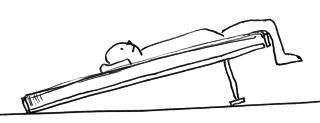
My tilted bed has its own page.
Bed with contra-shape
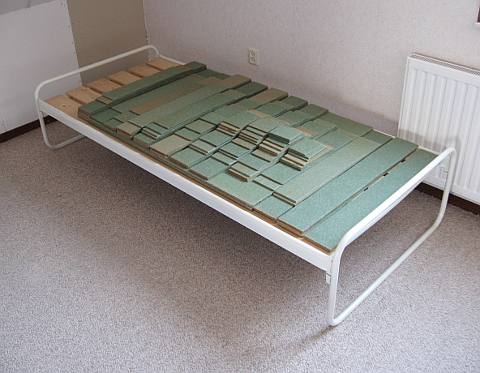
On an ordinary bed with a mattress, I had the problem that
the mattress in the middle was deeper than the sides of the mattress, when I was lying on it.
First I turned off the spirals by placing planks over them. But that was not enough.
So I made a contra-shape under the mattress, which pushes a little extra at some places in my back.
On the picture, the head of the bed is on the right. Especially in my upper back I want some more pressure.
The contra-shape is made of slats from green floor insulation boards.
Later I used slats of Styrofoam, which I wrapped in firm paper.
Alternating pressure mattress
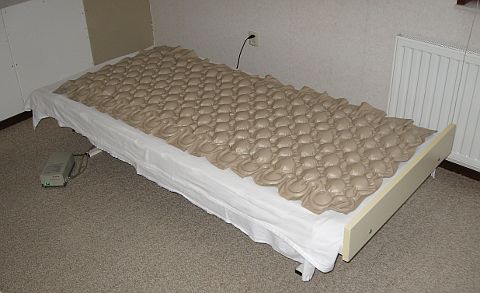
I wanted to keep my spine moving a little while I was asleep,
but it is difficult to make something mechanical.
Therefore I tried an alternating pressure mattress (also called ripple mattress).
Such a mattress has air compartments alternately.
First one part is inflated, and after about 3 minutes the other part is inflated.
That proved to work well.
An alternating pressure mattress can be bought, but can also be rented through medical home care.
That is quite expensive, but I was lucky and bought in 2009 an alternating pressure mattress
for only 55 euros.
Tip: If you only lie on your back, then an alternating pressure mattress
with a memory foam overlay on top is very good.
Such a memory foam mattress is approximately 5 cm thick.
If you also sleep on your side, perhaps you could place a pocket spring mattress underneath
the alternating pressure mattress.
The major disadvantage of an alternating pressure mattress is that the mattress is
not moisture-permeable. What I evaporating and sweat while I am sleeping,
is collected on the alternating pressure mattress.
It appeared that the alternating pressure mattress that I bought had unused compartments,
so I made holes in it. The moisture problem was thus solved.
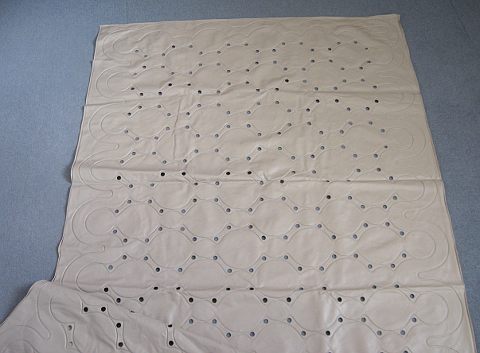

However, it turned out that is was no good for my neck, because of the motion and because
it is too soft for my neck.
In 2011 I had my mattress with layers,
with a separation between the part for my neck and the part for my back.
So I tried to place this alternating pressure mattress only under my back.
To prevent my pillow would shift, I attached a foam plate to the alternating pressure mattress,
as shown below. My pillow is placed on top of that green foam plate.
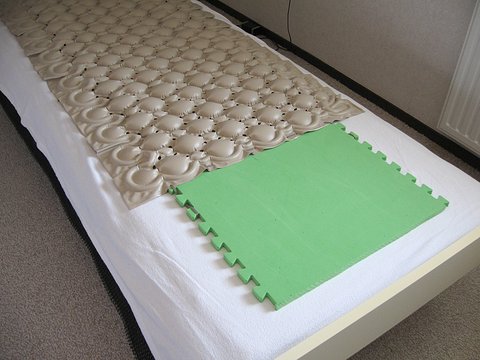


It turned out that this was still too much motion for my neck.
I've used it for a couple of weeks (which is a lot for me), but I got more and more dizzier and fatigued.
In 2011 I decided to make my own mattress with motion.
In 2019 I was able to go
swimming regulary.
With swimming my spine became less rigid and because of that,
I was able to use this alternating pressure mattress.
In January 2021 I lay mostly on this alternating pressure mattress for a few months.
Normally I lie on a much firmer bed with an elevation against my upper back vertebrae (I am lying on my back).
During all the hours that I sleep my upper vertebrae are given a lot of counter pressure to keep them from bending over
and getting stiffer. This was not the case with this alternating pressure mattress.
In January 2021, my upper back and lower neck vertebrae changed position and that area became stiff and
caused me a lot of trouble. Fortunately, the
musculoskeletal doctor Z4. (in Dutch) was able to improve it.
So I had no other option than not to use this alternating pressure mattress anymore.
Prone bed
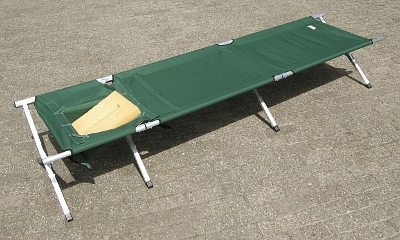
Because I only lie on my back, I wanted to vary that.
I can only lie prone if my head is not rotated.
My idea was to buy an examination table or massage table.
I would put a thin layer of memory foam on top.
And I would extend it, to fit my length.
The part where my head is, I would make that more comfortable.
It would also have to be lightweight and foldable.
Something like that will probably exist, but I could not find it.
So I bought a few camp beds. From two camp beds I made in 2009 one extra long camp bed,
suitable for my length. At the position of my head, I made a deepening.
I placed a form in the deepening on which my face rests.
The form consists of firm foam on the bottom, soft polyether foam
in the middle and memory foam on top.
A piece of stretch cotton is wrapped around it.
In the middle of that form is a slit of a 5 cm wide for my nose and to breathe.
For safety I made sure that the slit is always open.
So if I fall asleep, my breathing is not impeded.
This face down lounger was a good addition to my beds, because it puts my neck
in a other position.
Total weight: 6 kg.
Within a year the green fabric starts tearing, so I reinforced it.
The weight became 6.5 kg.
In 2013 I lie 1 to 2 hours per day on this bed. If I don't lie on it for a week,
I have more problems with fatigue. So apparently it is important for
the attitude of my neck.
In 2019, the canvas of the camp bed was worn out.
At this moment I don't know how to make a face down lounger that is
lightweight and lasts longer.
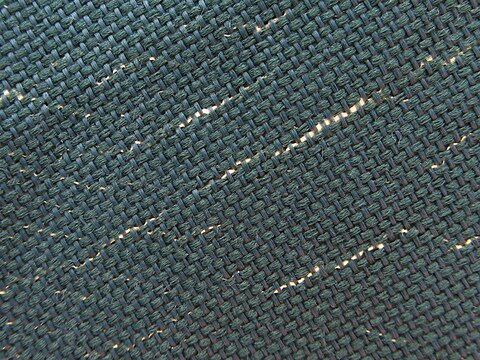
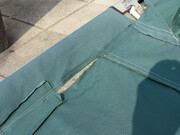
In 2021, I made a new one. I used the part with the deepening for the head cushion from the old one.
The canvas in the middle is now two layers.
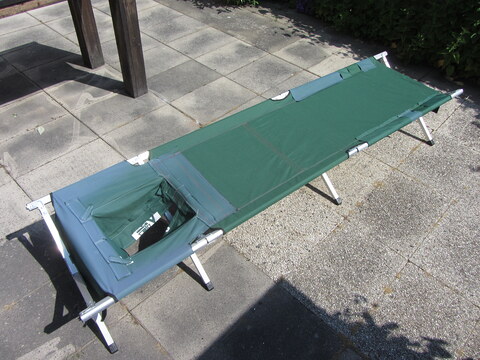
Mattress with layers
To be able to make my bed more comfortable, I put my mattress together myself.
I bought a number of foam layers (polyether foam, anti-condensation-mat (3D spacer fabric, 3D mesh layer), memory foam)
with different thicknesses and different softness.
The anti-condensation-mat is an very open woven plastic mat, that can be laid under the mattress.
At this moment I have 8 layers of foam.
I only lie on my back, and for my neck is better that my pelvis doesn't sink too deep.
So a thin mattress that still feels soft, seems the best.
Usually I put a firm foam on the bottom, and a layer of memory foam on top.
One combination of foam layers is sometimes a lot better than an other combination,
but usually I don't know why one combination is better than the other. Therefore I have
tried many combinations.
In the photos below you see my layers of foam,
then the two layers that I am going to use this time.
Next with a sheet over it. And finally with my pillow
("pillow with layers").
The mattress is not against the headboard, but keeps a free space for the pillow.
So the pillow is not on the mattress, but is lying directly on the bed.
This way I can determine more precisely the height and softness of my pillow.
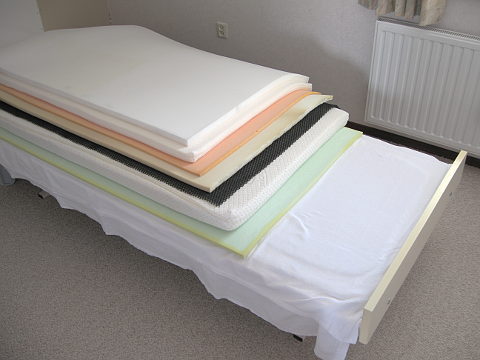
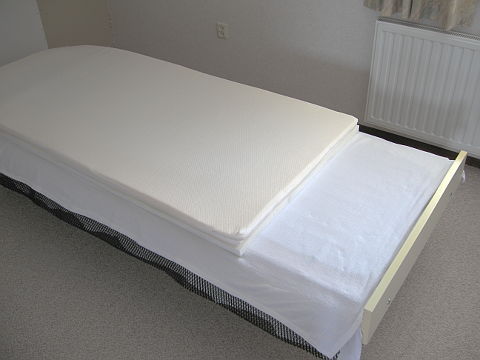
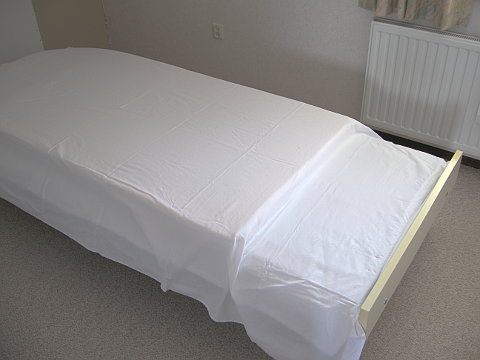
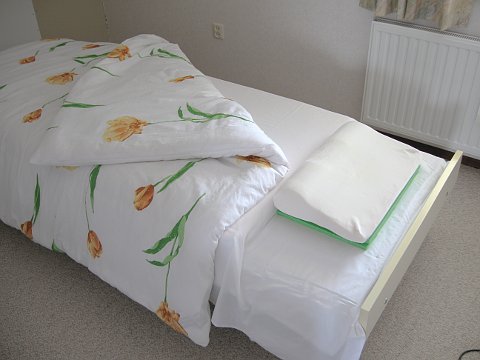
Over the years the layers on my bed have become quite complex.
Below is my description of my bed in 2011.
It is only the flat surface, the soft mattress layers go on top of that.
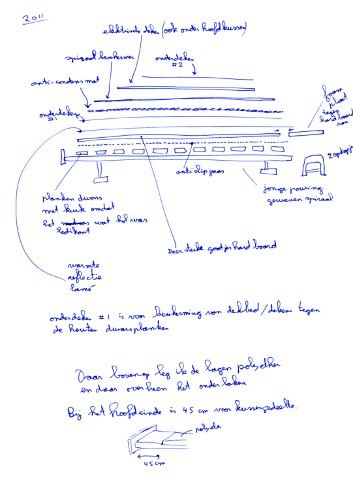
As shown in the picture above, the electric blanket is under the soft mattress layers.
That's because I usually place a memory foam layer as the top layer, and that does not go very well
with an electric blanket. A heat-reflecting layer is located under the electric blanket.
The electric blanket is also under my pillow, because I want keep specifically my neck and head warm.
I also extended my bed with two plastic stools. They turned out to be the same height as my bed frame.
In 2012 I added my mattress with motion to this bed.
Last change to this page: June 2021
















